Gag Grouper
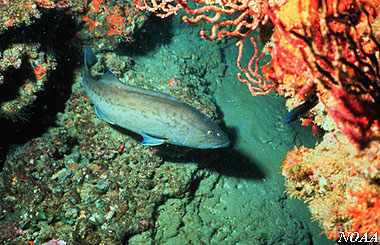
Mycteroperca microlepis
This oblong fish has small eyes over a pointed snout, and a continuous dorsal fin to a square caudal fin. Their colors vary by age and gender, but they range from gray to light brown with darker blotches or squiggles, giving it a faint marble pattern, or darker to a camouflage pattern. Like many groupers, they start out as females, and then change into males at a certain age or size after a few spawning seasons. They prefer rocky or grassy bottoms of coastal waters in the Western Atlantic, where they can hunt crustaceans and smaller fish, and grow to well over 4 feet long.
Order: Perciformes
Family: Serranidae
Genus: Mycteroperca
Species: microlepis
Common Names
English language common names include gag grouper, charcoal belly, gag, gag-velvet rockfish and velvet rockfish. Other common names are abadejo (Spanish), aguají (Spanish), badèche baillou (French), badejo (Portuguese), badejo brando (Portuguese), badejo-bicudo (Portuguese), badejo-branco (Portuguese), badejo-da-areia (Portuguese), badejo-saltão (Portuguese), badejo-sapateiro (Portuguese), cuna (Spanish), Cuna aguají (Spanish), fløjlsbars (Danish), garoupa (Portuguese), and serigado-badejo (Portuguese).
Importance to Humans
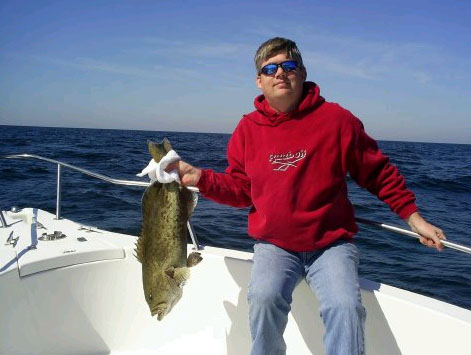
The gag grouper provides important recreational and commercial fisheries. It is caught with hook and line and the flesh is marketed fresh.
Danger to Humans
There have been reported cases of ciguatera from human consumption of gag grouper. Ciguatera poisoning is caused by dinoflagellates (microalgae) found on dead corals or macroalgae. By feeding on these corals and macroalgae, herbivorous fishes accumulate a toxin generated by these dinoflagellates. Largely a phenomenon of tropical marine environments, ciguatoxin accumulates still further in snappers and other large predatory reef species that feed on these herbivorous fishes. If accumulated levels of the toxin are great enough they can cause poisoning in humans whom consume the flesh of these fishes. Poisoned people report having gastrointestinal problems for up to several days, and a general weakness in their arms and legs. It is very rare to be afflicted with ciguatera poisoning.
Conservation
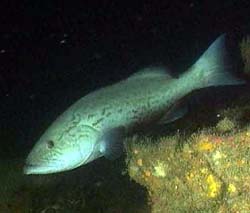
Ranked among the most valuable fisheries in the southeastern US, the gag grouper is sought after both recreationally and commercially. Due to fishing pressure, this species is vulnerable to overfishing. It is especially vulnerable when fish aggregate for spawning. The population of mature males has declined dramatically due to the targeting of larger fish, leading to concerns of insufficient males for reproductive efforts. Young gag grouper are often taken as bycatch in the shrimp fishery over seagrass beds.
> Check the status of the gag grouper at the IUCN website.
This species was last assessed in 1996. A taxon is considered vulnerable by IUCN when it is not critically endangered or endangered but is facing a high risk of extinction in the wild in the medium-term future. In the latest report of stock assessment, the gag grouper was not considered overfished (NMFS 2004), however it was indicated that a reduction in mortality was necessary because this species is considered to be experiencing overfishing. The IUCN is a global union of states, governmental agencies, and non-governmental organizations in a partnership that assesses the conservation status of species.
Geographical Distribution

The gag grouper is found in the western Atlantic Ocean from North Carolina (US) south to the Yucatan Peninsula (Mexico). It is scarce in waters surrounding Bermuda. Juveniles have been recorded as far north as Massachusetts. There have also been records of gag grouper occurring off the coasts of Bermuda, Cuba, and eastern Brazil.
Habitat
Residing in brackish to marine waters, the gag grouper is found offshore on rocky bottom as well as inshore on rocky or grassy bottoms to depths of 500 feet (152 m). It is common on rocky ledges along the eastern Gulf of Mexico.
Adult gag grouper school in groups of 5-50 individuals or may be found solitary. Recordings have been made of adult gag grouper producing thumping sounds through the swim bladder by vibrations resulting from the contraction of associated musculature. These sounds are produced during times when the fish is under duress.
Biology
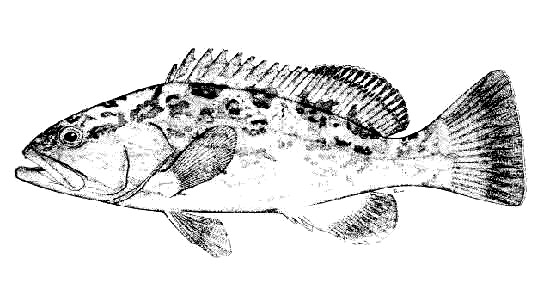
Distinctive Features
The gag grouper is typical among the groupers with an oblong-shaped elongate body. The head is long while the mouth is large with a protruding lower jaw. The bases of the dorsal and anal fins are covered with scales and thick skin. The caudal fin is large and has a slightly concave margin. This grouper is often confused with the black grouper (M. bonaci), however it is has some distinguishing characteristics. These include the shape of the caudal fin – the gag grouper has a slightly concave margin along the posterior edge of the caudal fin while the black grouper has square-shaped caudal fin. The preopercle (a boomerang-shaped bone whose edges form the posterior and lower margins of the cheek region; the most anterior of the bones comprising the gill cover) is angular and slightly notched with a distinct lobe. This characteristic also helps to distinguish the gag grouper from black grouper which has a gently rounded preopercle.
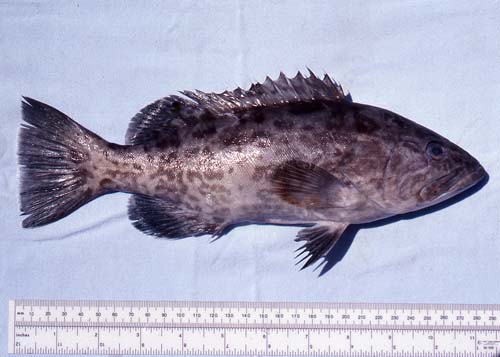
Coloration
Body color of the gag grouper is dependent upon the sex and age of the fish. Juveniles and mature females are pale to brown-gray with dark blotches and worm-shaped markings resulting in a marbled appearance. The caudal, anal, and pelvic fins have dark black-blue outer margins. Inactive individuals sometimes display a camouflaged pattern with dark brown “saddles” separated by white bars just below the dorsal fin. Large mature males are pale to medium gray in color with barely visible reticulations below the dorsal fin. The ventral surface is darker gray to black in color. The soft dorsal fin, caudal fin, pectoral, and pelvic fins are also dark gray to black while the margins of the anal and caudal fins are white. Individuals may exhibit a darker phase in which the posterior of the body, penduncle, soft dorsal fin, and anal fins are black in color.
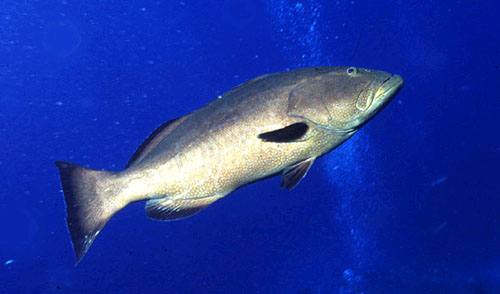
The gag grouper is often confused with the black grouper, however it may be distinguished based on the color of the fin margins. The caudal fin of the gag grouper has white margins on the anal and caudal fins while the black does not.
Dentition
There are two well-developed canine teeth present anteriorly in each jaw. These are quite effective for holding prey items.
Size, Age, and Growth
Gag grouper reach a maximum total length of 4.75 feet (1.45 m) and a maximum weight of 80.5 lbs (36.5 kg). Males reach maturity at approximately 8 years of age and a correlating total length of 39 inches (98 cm) while females mature at 5-6 years of age and 26-30 inches (67-75 cm) total length. This species is believed to have a lifespan of 16 years.
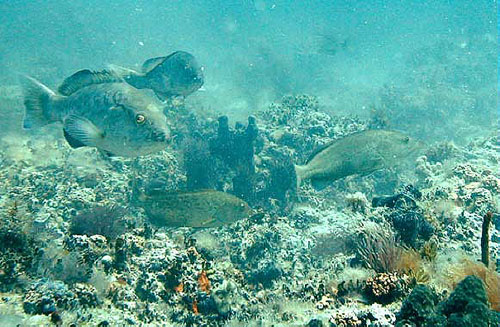
Food Habits
Adult gag grouper primarily feed on fishes, crabs, shrimps, and cephalopods while juveniles measuring less than 8 inches (20 cm) in length feed on crustaceans residing in shallow grass beds.
Reproduction
Similar to other serranids, gag grouper are protogynous hermaphrodites. They begin life as female, however after a few years of spawning as a female, some gag groupers change sex, becoming functional males. This transition generally occurs at 10-11 years of age corresponding to lengths of 37-39 inches (95-100 cm).
Spawning occurs from January through May in the Gulf of Mexico and the South Atlantic Bight at offshore spawning grounds. There is a major spawning ground on the west Florida Shelf. The fertilized eggs are pelagic and transparent, containing a single oil globule. Eggs hatch after approximately 45 hours at water temperatures of 70ºF (21ºC) (laboratory study). The kite-shaped larvae persist for 40-50 days, as postlarvae they migrate from the spawning grounds to inshore seagrasses, mangroves, oyster reefs and salt marshes. Juveniles remain in these locations for approximately 3-5 months before they migrate to offshore reefs.
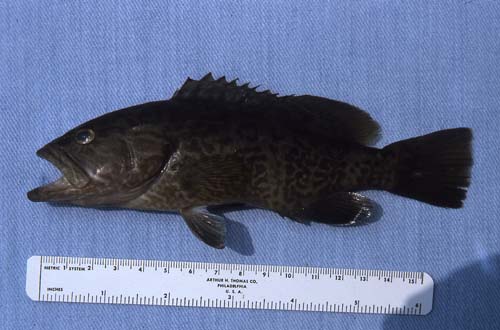
Predators
Juvenile gag grouper may fall prey to cannibalism as well as to large fishes. Sharks and other large fishes are known predators of adult gag grouper.
Parasites
Nematodes, including Porrocaecum sp. and Procamallanus pereirai, are known parasites of gag grouper. Another reported parasite of this grouper is the isopod, Exocorallana tricornis.
Taxonomy
This grouper was first described as Trisotropis microlepis by Goode and Bean in 1879. However, this name was later changed by taxonomists to the currently valid Mycteroperca microlepis (Goode and Bean, 1879). The genus name, Mycteroperca, is derived from the Greek, “mykter, -eros” meaning nose and “perke” meaning perch. The species name, microlepis, is derived from the Greek “micro” small and “lepis” meaning scale, in reference to the small scales covering the body of this fish.
Prepared by: Cathleen Bester